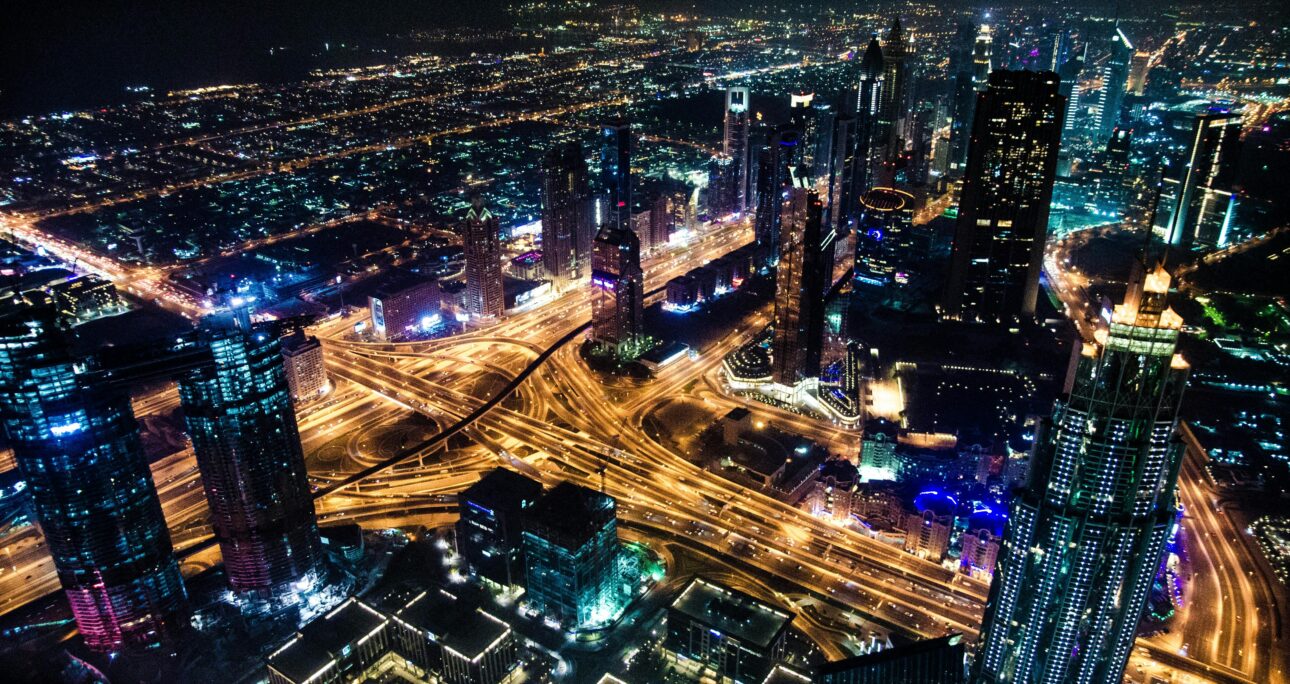In an era of rapid urbanization and unprecedented technological advancement, smart cities are emerging as the definitive solution to the most complex urban challenges of our time. These intelligent urban ecosystems are leveraging cutting-edge technologies to radically transform residents’ quality of life, improve environmental sustainability, and revolutionarily optimize municipal operations.
As more than half of the world’s population lives in urban areas, with this figure projected to reach 68% by 2050, the need for more efficient, sustainable, and intelligent cities has never been more urgent. Smart cities represent a perfect convergence between technological innovation and basic human needs, creating urban environments that not only respond to current challenges but anticipate and adapt to future needs.
1. Intelligent Traffic Management: The Urban Mobility Revolution
Traffic congestion represents one of the most persistent and costly problems in modern cities, causing not only millions in economic losses from wasted time, but also contributing significantly to air pollution and deteriorating urban quality of life. Intelligent Traffic Management Systems (ITMS) are completely transforming this landscape with innovative technological solutions.
AI-Powered Traffic Lights
Traditional traffic lights operate with preset cycles that don’t consider real traffic conditions. New intelligent traffic light systems use machine learning algorithms to analyze real-time traffic data, including vehicle volume, average speed, and pedestrian flow patterns. These systems can dynamically adjust signal timings, reducing wait times at intersections by up to 40% and significantly improving vehicular flow.
The technology goes beyond simply changing timings. Smart traffic lights can communicate with each other to create coordinated “green waves,” allowing vehicles to move through multiple intersections without stopping. This coordination can reduce total travel time by up to 25% during peak hours.
Advanced Traffic Flow Prediction
Modern predictive systems combine historical data with real-time information from multiple sources: traffic sensors, surveillance cameras, vehicle GPS data, navigation apps, and even weather information. Using artificial intelligence and big data analytics, these systems can predict traffic patterns with up to 90% accuracy, enabling:
- Proactive Route Management: Drivers receive alternative route suggestions before congestion occurs, distributing traffic more evenly throughout the city.
- Event Planning: Authorities can anticipate and mitigate traffic impact during special events, construction, or emergencies.
- Resource Optimization: Maintenance and emergency teams can position themselves strategically based on predicted traffic patterns.
Smart Parking: Eliminating Frustrating Searches
Urban parking traditionally consumes significant resources for both drivers and cities. IoT sensors installed in individual parking spaces communicate with central systems and mobile applications, providing real-time availability information. This technology offers multiple benefits:
- Reduced Search Traffic: Eliminating the need to circulate looking for parking can reduce up to 30% of urban traffic in dense commercial areas.
- Dynamic Price Management: Prices can automatically adjust based on demand, optimizing the use of available spaces.
- Advance Reservations: Drivers can reserve and pay for spaces before arriving at their destination, improving trip planning.
Public Transportation Optimization
Real-time data is revolutionizing public transportation through systems that constantly monitor the location, capacity, and conditions of buses, trains, and other public vehicles. This information enables:
- Dynamic Schedules: Timetables automatically adjust based on traffic conditions and passenger demand.
- Real-Time Information: Stops and stations provide updated information about arrivals, delays, and vehicle capacity.
- Route Optimization: Routes can be temporarily modified to avoid congestion or better serve high-demand areas.
2. Smart Energy Infrastructure: Towards Total Sustainability
The transition toward truly sustainable cities requires a complete revolution in how we generate, distribute, and consume energy. Smart grids represent the heart of this transformation, creating energy systems that are not only more efficient but also more resilient and adaptable.
Bidirectional Power Grids
Smart grids enable bidirectional electricity flow, where consumers can also become producers. Residential solar panels, small wind turbines, and home storage systems can feed energy back into the grid during low-demand periods. This decentralization reduces dependence on large power plants and increases system resistance to failures.
Intelligent Demand Management
Demand management systems use predictive analytics to anticipate energy consumption peaks and automatically adjust distribution. During high-demand periods, these systems can:
- Automatically Reduce Non-Essential Consumption: Air conditioning systems, decorative public lighting, and other non-critical services can temporarily reduce their consumption.
- Activate Reserve Sources: Battery systems and alternative energy sources automatically activate to meet additional demand.
- Incentivize Deferred Consumption: Consumers receive economic incentives to use appliances during low-demand periods.
Smart Buildings and Energy Efficiency
Smart buildings integrate sensors, automation, and data analytics to continuously optimize energy consumption. These systems monitor and control:
- Adaptive Lighting: Lighting automatically adjusts based on available natural light, occupancy, and specific activities in each area.
- Predictive Climate Control: HVAC systems use weather data, occupancy patterns, and user preferences to maintain optimal conditions with minimal energy consumption.
- Electrical Load Management: Buildings can automatically schedule appliance and equipment use to take advantage of lower-cost energy periods.
3. Smart Water Management: Preserving Our Most Valuable Resource
Water represents one of the most critical resources for modern cities, and intelligent water management is transforming how cities monitor, distribute, and conserve this vital resource. Smart water management systems combine IoT sensors, data analytics, and automation to create more efficient and sustainable water networks.
Early Leak Detection
Losses from leaks in water distribution systems can represent up to 30% of total supply in some cities. Acoustic and pressure sensors installed throughout the pipeline network can detect anomalies indicating potential leaks, enabling proactive repairs before they become major problems. This technology can reduce water losses by up to 50%.
Real-Time Quality Monitoring
Sensors distributed throughout the distribution network continuously monitor parameters such as pH, residual chlorine, turbidity, and specific contaminants. If anomalies are detected, the system can automatically isolate affected sections and alert health authorities, proactively protecting public health.
Smart Stormwater Management
Intelligent drainage systems use weather forecasts and level sensors to proactively manage stormwater. During intense storms, these systems can:
- Automatically Open and Close Gates: Directing water flow toward temporary storage areas or infiltration systems.
- Alert About Flood Risks: Providing early warnings to residents and emergency services.
- Optimize Treatment: Directing stormwater to treatment plants when capacity allows.
4. Smart Urban Security: Proactive Protection and Rapid Response
Urban security is experiencing a radical transformation through the integration of advanced technologies that not only respond to incidents but actively prevent them. Smart security systems combine advanced video surveillance, behavior analysis, environmental sensors, and automated coordination between emergency services.
Intelligent Video Surveillance and Predictive Analytics
Modern security cameras go far beyond simply recording. They use artificial intelligence to analyze behavior patterns in real-time, automatically identifying:
- Anomalous Behaviors: The system can detect fights, thefts, vandalism, or medical emergency situations without human intervention.
- Suspicious Object Recognition: Automatic identification of abandoned packages, vehicles in unauthorized locations, or weapons.
- Crowd Analysis: Monitoring people density in public spaces to prevent dangerous overcrowding situations.
Early Warning Systems
Environmental sensors distributed throughout the city can detect a wide range of potential threats:
- Gunshot Detection: Acoustic sensors that can instantly identify and locate gunshots, alerting authorities and providing precise locations.
- Air Quality Monitoring: Early detection of toxic emissions, fires, or dangerous atmospheric pollution.
- Seismic Sensors: Continuous monitoring of seismic activity to provide early earthquake warnings.
Automated Emergency Service Coordination
When an emergency is detected, intelligent systems can automatically coordinate the response:
- Optimized Dispatch: Automatic selection of the closest and best-equipped emergency units for each specific situation.
- Route Optimization: Real-time calculation of the fastest routes considering current traffic, construction, and other obstacles.
- Integrated Communication: Automatic coordination between police, fire department, medical services, and other relevant services.
5. Digital Government and Citizen Participation: Democracy in the Digital Age
The digital transformation of municipal government is creating new forms of interaction between citizens and authorities, making public services more accessible, efficient, and transparent. Digital platforms are democratizing access to government information and services.
Digitized Public Services
Service digitization allows citizens to conduct business from anywhere at any time:
- Online Licenses and Permits: Application, tracking, and obtaining construction licenses, commercial permits, and other official documents completely online.
- Integrated Payments: Unified systems for paying taxes, fines, public services, and other municipal charges.
- Digital Records: Citizens can access their complete history of interactions with municipal government.
Enhanced Citizen Participation
Digital technologies are creating new channels for democratic participation:
- Public Consultation Platforms: Online tools that allow citizens to participate in debates about public policies, participatory budgets, and urban planning.
- Real-Time Feedback Systems: Applications that allow citizens to report urban problems, from potholes to damaged street lights, with automatic progress tracking of repairs.
- Secure Electronic Voting: Digital voting systems for citizen consultations and local elections, increasing participation and reducing costs.
Transparency and Open Data
Open data initiatives are making government information more accessible:
- Transparency Portals: Automatic publication of information about public spending, government contracts, and municipal performance indicators.
- Public APIs: Interfaces that allow developers and civil organizations to create applications using government data.
- Citizen Dashboards: Public control panels showing real-time city performance indicators.
The Future of Smart Cities: Integration and Continuous Evolution
The smart cities of the future will not simply be collections of isolated technologies, but integrated ecosystems where each system communicates and collaborates with others. The convergence of artificial intelligence, Internet of Things, 5G, blockchain, and other emerging technologies will create cities that are truly adaptive and resilient.
System Integration
The future of smart cities lies in complete integration of all urban systems. A unified urban management system will be able to:
- Coordinate Automatic Responses: When a fire is detected, the system will not only alert firefighters but also optimize traffic routes for their arrival, notify nearby hospitals, and activate evacuation systems.
- Holistic Optimization: Decisions about energy, water, transportation, and security will be made considering effects on all other urban systems.
- Continuous Learning: Systems will constantly learn from each interaction, continuously improving their ability to serve citizens.
Sustainability and Resilience
The smart cities of the future will be designed from the ground up to be sustainable and resilient to climate change. This includes:
- Carbon Neutrality: Integrated systems that continuously monitor and minimize carbon emissions from all urban operations.
- Climate Adaptation: Infrastructure that can automatically adapt to extreme and changing weather conditions.
- Circular Economy: Systems that minimize waste through recycling, reuse, and resource optimization.
Conclusion: A Transformed Urban Future
Smart cities represent more than a simple technological evolution; they constitute a fundamental transformation in how we conceive and live urban life. By integrating advanced technologies with basic human needs, these cities promise to create urban environments that are not only more efficient and sustainable but also more human and livable.
The successful implementation of smart cities requires collaboration between governments, the private sector, academia, and citizens. It is essential that these technologies be implemented ethically and equitably, ensuring that all citizens, regardless of their socioeconomic level, can benefit from these innovations.
The urban future that awaits us is bright, with cities that anticipate our needs, protect our environment, and continuously improve our quality of life. Smart cities are not just the future; they are emerging today, gradually transforming our urban environments into smarter, more sustainable, and more livable spaces for everyone.


